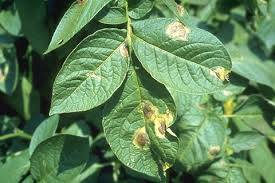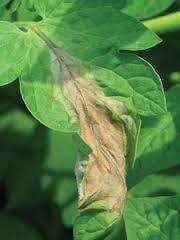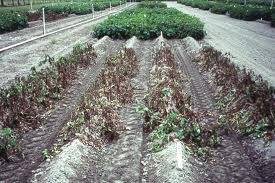Philemon Buruzi
Of late there has been increased interest in the cultivation of potatoes in Zimbabwe. The advent of the sack potato technology has fanned the flame to levels never imagined before. This has seen a number of farmers trying their luck with this wonderful crop which apart from being relatively rewarding financially, harbours the potential to contribute meaningfully towards attainment of household food security. I however have noted one sad scenario during the advisory visits that I make to different farms around the country. Amid the excitement of taking on a new technology and the prospects of a wonderful harvest, punctuated by the anticipated cash inflow from the resultant sale of the crop, many a farmer have forgotten to attend to one critical aspect of the whole show, i.e disease control. Sadly this has led to massive collapse of many projects to date. That has prompted me to put together this article which is one in a four-part series meant to address the most devastating and economically important potato diseases in a bid to hedge in the farmers’ bottom line. One such disease is late blight.
Late Blight
Late Blight is a disease of potatoes caused by a fungus that affects the potato leaves, stems as well as the tubers. This disease proliferates well in conditions of high humidity and daytime temperatures ranging between 17-210C and corresponding night time temperatures of between 10-160C. Late blight normally manifests when moist conditions persists for 7-10hrs on end. These conditions favours rapid sporulation of the fungus, which is the way by which the fungus multiplies to form infective spores which are then carried forward to colonise new plant materials or tubers. The disease can be transmitted from one crop generation to the other via the use of infected tubers as seeds. It can also spread from one plant to the next through the air when infective spores are released from an affected plant after successful sporulation. Another way by which late blight is transmitted is when spores are washed off the infected leaves or stems by rain water or irrigation and get an opportunity to interact with the growing tubers at the base of the plant. This is especially common in the case of tubers that are not well covered by the soil. In addition affected stems and /or leaves can spread the infection to tubers during harvesting by direct contact. In a similar manner spoiled tubers with well sporulated fungi can pass on the infection to other tubers whilst in storage. The possibility of such a scenario is particularly high when storage conditions are such that ventilation is limiting to an extent that humidity rises to levels that enhance sporulation of the infective fungus.
How to positively identify Potato Late Blight
Leaves- one can identify late blight by its effects on the leaves where it starts off by causing small light- to –dark green water-soaked spots that are surrounded by a yellow ring as shown in the photo below.

In no time the affected area enlarges and turns either brown or purplish black. The affected area is not limited by leaf veins as they expand and tend to coalesce with other new infections blighting and killing the whole leaf in a few days. When the affected leaves dry out they become brittle and easily crackle and fall off. Upon turning over the affected leaf one normally observes a white mouldy growth bordering or entirely covering the affected area.

Stem – late blight lesions can also affect the stems and petioles. Affected stem normally turn black and rot but do not become spongy. In case of persistent cool but humid conditions the affected area can be seen covered with whitish moulds rapidly spreading across the stems and branches. When the disease settles for the stems it is often very difficult to pick it during scouting because the foliage covers up the affected areas and the leaves show no signs of ill-health at all.
Tubers- affected tubers shows irregular and slightly depressed area of brown-purplish skin. When cut to observe the inside tissue, one is bound to notice some brown granular rot that extends less than 4cm into the tuber. Tubers can be shrivelled as older lesions become firm and sunken due to water loss. Affected tubers rapidly develop a cotton-like mould on the surface when stored under highly humid conditions.
Differential diagnosis
The way the late blight fungus manifests in leaves, one can easily confuse it with early blight if they are not prudent in their observations. For one to ascertain that they have a case of late blight they should note that the affected areas in the case of late blight progress without being checked by leaf veins. On the contrary, in early blight the lesions are limited by the veins of the leaves and as a result tend to appear angular in shape.
When it affects the stems one might be easily persuaded to confuse this disease with other diseases like soft rot and blackleg. However when you scrutinize closely and notice that it the affected stems have become spongy be positive that what you have could be the latter as late blight does not result in spongy stems.
How to control Potato Late Blight
The most basic way of avoiding potato late blight is by ensuring that you do not introduce the disease onto your farm by always using certified seed which is sure to be free of the disease. One can also strive to procure and use late blight resistant cultivars always so as to thwart unduly introduction and proliferation of this disease. Farmers are also urged to destroy all cull piles and volunteers after every crop cycle. There is also need to strictly monitor the levels of nitrogen fertiliser applied onto the field during the growing period because excessive quantities of nitrogen in the soil predisposes the crop to the disease. A farmers whose crop has had an attack of late blight should thereafter ensure that his crop has got a good soil cover in order to shield the tubers from infection. It is recommended that farmers apply fungicides to discourage the growth of the fungus. Field scouting should be done regularly in order to be able to detect the disease before it spreads far and wide beyond containment.
It remains important that a farmer kills all the vines and continues to apply fungicides until the plant is completely dead. Lifting of potatoes should be done when the potato plant is completely dead and dried up to avoid transfer of the infective material to the tubers. Avoid harvesting under wet conditions as this normally is recipe for disaster especially when the aerial parts of the plants have been affected. In case some of the tubers have been affected but have escaped your notice it is possible to curtail the spread of the disease during storage by discouraging accumulation of humidity as well as temperature through maintenance of good ventilation.

For all questions and comments: philemonburuzi@gmail.com. Responses will be provided within the shortest possible time.
http://www.agriuniverse.co.zw

